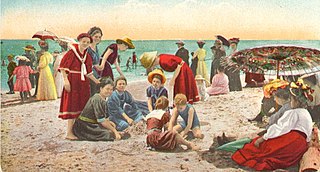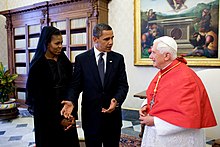
Vatican City, officially the Vatican City State, is a landlocked sovereign country, city-state, microstate, and enclave within Rome, Italy. It became independent from Italy in 1929 with the Lateran Treaty, and it is a distinct territory under "full ownership, exclusive dominion, and sovereign authority and jurisdiction" of the Holy See, itself a sovereign entity under international law, which maintains the city-state's temporal power and governance, diplomatic, and spiritual independence. The Vatican is also a metonym for the pope, Holy See, and Roman Curia.
The politics of Vatican City take place in a framework of a theocratic absolute elective monarchy, in which the Pope, religiously speaking, the leader of the Catholic Church and Bishop of Rome, exercises ex officio supreme legislative, executive, and judicial power over the Vatican City as it is being governed by the Holy See, a rare case of non-hereditary monarchy.

The Dicastery for the Doctrine of the Faith (DDF) is a department of the Roman Curia in charge of the religious discipline of the Catholic Church. The Dicastery is the oldest among the departments of the Roman Curia. Its seat is the Palace of the Holy Office in Rome. It was founded to defend the Catholic Church from heresy and is the body responsible for promulgating and defending Catholic doctrine.

Modesty, sometimes known as demureness, is a mode of dress and deportment which intends to avoid the encouraging of sexual attraction in others. The word modesty comes from the Latin word modestus which means 'keeping within measure'.

The Society of Saint Pius X is a canonically irregular traditionalist Catholic fraternity of priests founded in 1970 by Archbishop Marcel Lefebvre. Lefebvre was a leading traditionalist at the Second Vatican Council with the Coetus Internationalis Patrum and Superior General of the Holy Ghost Fathers until 1968. The society was initially established as a pious union of the Catholic Church with the permission of François Charrière, the Bishop of Lausanne, Geneva and Fribourg in Switzerland.

Abortion laws vary widely among countries and territories, and have changed over time. Such laws range from abortion being freely available on request, to regulation or restrictions of various kinds, to outright prohibition in all circumstances. Many countries and territories that allow abortion have gestational limits for the procedure depending on the reason; with the majority being up to 12 weeks for abortion on request, up to 24 weeks for rape, incest, or socioeconomic reasons, and more for fetal impairment or risk to the woman's health or life. As of 2022, countries that legally allow abortion on request or for socioeconomic reasons comprise about 60% of the world's population. In 2024, France became the first country to explicitly protect abortion rights in its constitution.

Le privilège du blanc is a custom of the Roman Catholic Church that permits certain designated female royalty to wear white clothing during an audience with the pope. It is an exception to the traditional requirement of women to wear black garments on such occasions, which has become optional since the 1980s.
The hierarchy of the Catholic Church consists of its bishops, priests, and deacons. In the ecclesiological sense of the term, "hierarchy" strictly means the "holy ordering" of the church, the Body of Christ, so to respect the diversity of gifts and ministries necessary for genuine unity.

Renato Raffaele Martino is an Italian prelate of the Roman Catholic Church. He has been a cardinal since 2003. He has been the longest serving cardinal deacon, the cardinal protodeacon, since June 2014. He served for more than twenty years in the diplomatic service of the Holy See, including sixteen years as Permanent Observer of the Holy See to the United Nations. He held positions in the Roman Curia from 2002 to 2009.

The Vatican City national football team is the football team that represents Vatican City under the control of the Vatican Amateur Sports Association, headquartered in the Vatican's Cortile di San Damaso. The Vatican City football association was founded in 1972. Its current president is Domenico Ruggiero. Massimiliano Strapetti, an Italian, is the current head coach.
The Supreme Tribunal of the Apostolic Signatura is the highest judicial authority in the Catholic Church. In addition, it oversees the administration of justice in the church.

In the Catholic Church, a bishop is an ordained minister who holds the fullness of the sacrament of holy orders and is responsible for teaching doctrine, governing Catholics in his jurisdiction, sanctifying the world and representing the Church. Catholics trace the origins of the office of bishop to the apostles, who it is believed were endowed with a special charism and office by the Holy Spirit at Pentecost. Catholics believe this special charism and office has been transmitted through an unbroken succession of bishops by the laying on of hands in the sacrament of holy orders.

The following outline is provided as an overview of and introduction to Vatican City:

Abortion in Andorra is illegal in all cases; the Co-Princes of Andorra are the President of France and the Bishop of Urgell, who is required to adhere to Roman Catholic teaching on pregnancy. Around 88% of its population identifies as Roman Catholic.

The 1983 Code of Canon Law, also called the Johanno-Pauline Code, is the "fundamental body of ecclesiastical laws for the Latin Church". It is the second and current comprehensive codification of canonical legislation for the Latin Church of the Catholic Church. The 1983 Code of Canon Law was promulgated on 25 January 1983 by John Paul II and took legal effect on the First Sunday of Advent 1983. It replaced the 1917 Code of Canon Law which had been promulgated by Benedict XV on 27 May 1917.

Abortion in Colombia is freely available on request up to the 24th week of pregnancy, due to a ruling by the Constitutional Court on February 21, 2022. Later in pregnancy, it is only allowed in cases of risk of death to the pregnant woman, fetal malformation, or rape, according to a Constitutional Court ruling in 2006.
The official teachings of the Catechism of the Catholic Church promulgated by Pope John Paul II in 1992 oppose all forms of abortion procedures whose direct purpose is to destroy a zygote, blastocyst, embryo or fetus, since it holds that "human life must be respected and protected absolutely from the moment of conception. From the first moment of his existence, a human being must be recognized as having the rights of a person – among which is the inviolable right of every innocent being to life". However, the Church does recognize as morally legitimate certain acts which indirectly result in the death of the fetus, as when the direct purpose is removal of a cancerous womb. Canon 1397 §2 of the 1983 Code of Canon Law imposes automatic excommunication on Latin Catholics who actually procure an abortion, if they fulfill the conditions for being subject to such a sanction. Eastern Catholics are not subject to automatic excommunication, but by canon 1450 of the Code of Canons of the Eastern Churches they are to be excommunicated by decree if found guilty of the same action, and they may be absolved of the sin only by the eparchial bishop. In addition to teaching that abortion is immoral, the Catholic Church also generally makes public statements and takes actions in opposition to its legality.
The law of Vatican City State consists of many forms, the most important of which is the canon law of the Catholic Church. The organs of state are governed by the Fundamental Law of Vatican City State. The Code of Penal Procedure governs tribunals and the Lateran Treaty governs relations with the Italian Republic.

Fernando Vérgez AlzagaL.C. is a Spanish prelate of the Catholic Church who has been President of the Pontifical Commission for Vatican City State and President of the Governorate of Vatican City State since 1 October 2021. He was Secretary General of the Governorate of Vatican City State from 2013 to 2021 and before that director of the Vatican City State Telecommunications Directorate.
Pascite gregem Dei is an apostolic constitution issued by Pope Francis on 1 June 2021 which reforms Book VI of the 1983 Code of Canon Law. It took effect on 8 December 2021.















